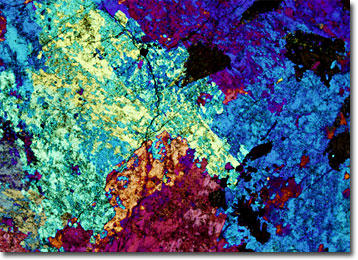Polarized Light Microscopy Digital Image Gallery
Hornblende Syenite
The term syenite was coined by the early Roman scholar Pliny the Elder, who utilized it as a designation for rocks that appeared similar to the hornblendic granite of Syene in Egypt, which was widely used in antiquity as a building material. However, in modern times, the word has come to refer to any of a class of plutonic rocks basically composed of feldspar and a ferromagnesian mineral.

Syenites are coarse-grained intrusive rocks that are relatively rare on Earth. The best-known occurrences of them can be found in the United States and Germany, where they are sometimes quarried for use as building stones. As noted by Pliny the Elder, the texture of syenites is the same as that of granites, the primary difference between the two being only the amount of quartz they contain. Syenites are often differentiated from one another based upon their constituent ferromagnesian mineral. Some of the most common types of the rock observed are hornblende syenite, augite syenite, and mica syenite.
Hornblendes are a subgroup of amphibole minerals that contain significant amounts of calcium and are monoclinic. Quite common, hornblendes are associated with a wide variety of rocks, such as syenites, granites, gneisses, and gabbros. The minerals are typically opaque and dark green to black in color with a vitreous to dull luster. Also, hornblende crystals may be prismatic or long and thin, and they sometimes occur in massive, granular aggregates as well. Notable deposits of hornblendes can be found in New York, Norway, Italy, and Ontario, Canada.
